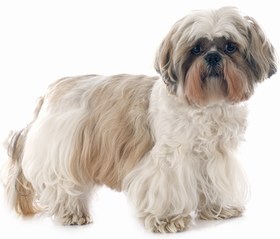
Paws ‘N’ Pups Quickview
Size
| Energy Level
| Trainability
| Paws ‘N’ Pups Rank
|
Characteristics
| Physical Characteristics: Height: 8-11” Weight: 7-13 lbs. Energy Level: Moderate | Colors: The American Kennel Club recognizes the Havanese in 16 different colors including the following:
Havanese are often found with cream, tan, silver, or white markings. |
| Health & Longevity: 13-15 years Breeders screen for the following conditions:
Liver shunts are sometimes seen, as is deafness in dogs with a lot of white, especially on their head. Chondrodysplasia (dwarfism) exists in the breed, as does Legg Calve Perthese, a disease that causes degeneration of the head of the femur bone, which in turn causes pain and stiffness. | |
Temperament & Train-ability
Native to Cuba, the Havanese shares ancestry with the Bichon. Originally bred as companions for the royal families of Cuba, this happy, affectionate and playful dog delights and is delighted by everyone he meets. Small but sturdy (one of the sturdier toy breeds), the Havanese makes a gentle family companion unsuited to living outdoors or spending long hours alone. They are well suited to apartments, condos or those with small yards and generally get along well with other animals. Although the Havanese usually showers everyone he meets with sincere affection, some can be wary of strangers. They also make good watchdogs.
Exercise needs are easily satisfied with long daily walks and play sessions; your Havanese will also enjoy the interaction and mental stimulation of training, whether for tricks or competitions. Most Havanese enjoy playing with toys and entertaining their families with their charming antics. True to his breeding as a companion, your Havanese will barely want to leave your side, and can be anxious when left alone. Training him to enjoy special chews or interactive toys in your absence can reduce this.
Havanese will need early and ongoing socialization to assure they mature into confident, happy adults. Housetraining a Havanese can be difficult; many owners opt for an indoor potty option for their dogs, such as pee pads or another type of potty tray. This ensures an acceptable location for the dog to relieve itself is always close by, reducing the likelihood of accidents in unwanted places. They should also be taught to tolerate brief periods of time alone, enjoying a chew or food-stuffed toy; this will help reduce the likelihood of separation anxiety developing.
Social and intelligent, the Havanese typically learns quickly, especially when positive reinforcement methods are used. Indeed, there is little reason to use punitive, forceful methods on such a devoted, willing and sensitive little dog. Doing so may shatter their trust in you and leave them confused and afraid. These bright dogs often enjoy playing with toys, which can be incorporated into training. Many Havanese compete in dog sports like agility, freestyle and flyball. They can make amazing therapy dogs, and some have worked as assist dogs. With a lifetime of grooming ahead of them, it is wise to teach your Havanese puppy to enjoy the process. Start with short sessions, or take the puppy to the groomer for ‘introductory’ sessions.
Grooming
The Havanese’ beautiful coat is thick, long and silky soft, with a light loft; it can be straight, wavy or curly. The coat does not shed easily, which means matting will result if not brushed; left long, the coat requires thorough daily brushing and combing to keep it mat free. Many owners opt to have the coat clipped short; be aware, even if kept short, the Havanese’ ears and tail must be brushed daily. Regular baths will keep your Havanese fresh.
During spring and fall, the coat will “blow”, allowing new coat to come in; during these times, shedding will increase dramatically and brushing more frequently will lessen the hair falling in your house. Ears must be cleaned regularly, and toenails should be trimmed, as most Havanese won’t wear their nails down, even if walked on concrete. Teeth should also be checked and cleaned as necessary.
Diet
The amount of food a Havanese will require can vary depending on age, activity level, and type of food fed. On average, Havanese will eat ½ – 1 cup of food, fed in two meals per day; a high quality food should be fed. Free feeding should be avoided, as many Havanese are prone to becoming overweight, which puts them at risk of many health problems. A portion of your dog’s daily food can be used when training to avoid overfeeding. A constant supply of fresh, clean water must always be available.
Looking for a Havanese?
 Find A Havanese Breeder |  Havanese Puppies For Sale |  Adopt A Havanese |
Cost
Prices for Havanese vary widely, running from the $600-$1,500 range on up to $2,000. Breed rescue organizations are another option, where lovely dogs needing a home can be found; adoption fees vary widely, but are generally in the $200-$500 range. Whether you acquire a dog from a breeder or rescue, do your homework to be assured that the temperaments of the dogs are tested and sound. Ongoing expenditures include the typical supplies, food, and regular vet visits.
Paws ‘N’ Pups Ranking
Paws ‘N’ Pups ranks every breed out of 4 with 1 being easiest to integrate into your life and 4 being the toughest – The lower the ranking the better.
Ranking takes into account a few basic factors such as cost, skill level needed, high vs. low maintenance, and how critical regular training is to success. The Havanese rates a 2.5, primarily due to their cost and grooming needs.
Breeds Similar To Havanese
 Shih Tzu |  Pomeranian |  Bichon Frise |  Pekingese |




